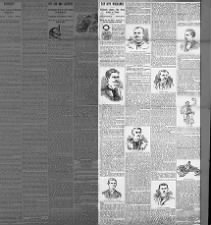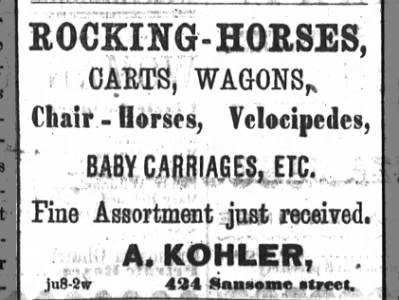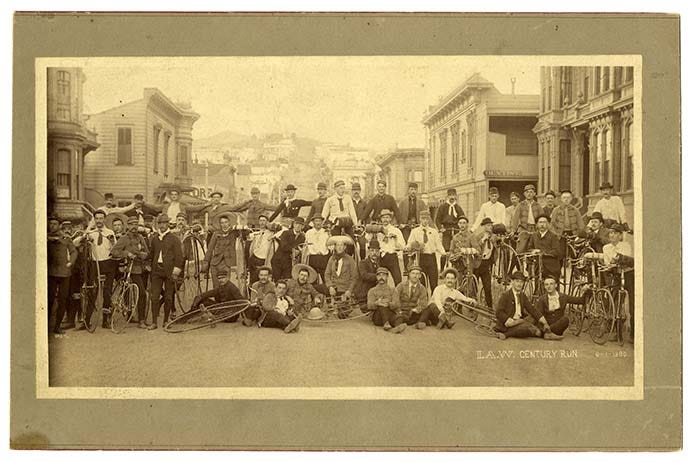BAY CITY WHEELMEN, Well-Known Athletes Who Travel Around on Wheels. - Sun, Oct 14, 1888 - 9 - The San Francisco Examiner
 BAY CITY WHEELMEN Well-Known Athletes Who Travel Around on Wheels
Sun, Oct 14, 1888 – 9 ·
The San Francisco Examiner (San Francisco, California) ·
Newspapers.com
BAY CITY WHEELMEN Well-Known Athletes Who Travel Around on Wheels
Sun, Oct 14, 1888 – 9 ·
The San Francisco Examiner (San Francisco, California) ·
Newspapers.com
BAY CITY WHEELMEN
Well-Known Athletes Who Travel Around on Wheels.
CALIFORNIA CYCLISTS.
How the Sport Has Grown in Interest Since it Was First Introduced on This Coast.
OF all the athletic sports that have ever been introduced on this coast no particular one has made such rapid strides toward perfection as cycling has.
Any of the older local residents will remember when, in the 60's, Union square was covered by the Exposition building of the Mechanics' Institute. It was in those days that an enterprising little Yankee received, by the way of Cape Horn, some hundred or more well-used but still solid velocipedes, that had outlived their usefulness in France and were sold to him for a song, because they were too heavy. The wheels were of even size and weight, and the rider sat between them, having to kick out almost horizontally to keep himself going. Well, these velocipedes were cleaned up a little, oiled, and for the first time San Franciscans were given an opportunity to indulge in a sport they had heard of but never tried. velocipedes, first mention in San Francisco county newspapers A.
Kohler
Fri, Jun 8, 1866 – Page 2 ·
San Francisco Chronicle (San Francisco, California) ·
Newspapers.com
velocipedes, first mention in San Francisco county newspapers A.
Kohler
Fri, Jun 8, 1866 – Page 2 ·
San Francisco Chronicle (San Francisco, California) ·
Newspapers.com
With the only available machines the sport assumed an air of hard work, but its attractiveness overcame that, and day and night the owner of the velocipedes had them let out to customers, who found it necessary to apply for one many hours in advance so as to make sure of getting it. There was no such thing as road traveling at that time, for the reason that there was little else but sandhills in the neighborhood, and no rider could possibly indulge in the new craze for more than an hour at a time, when he required a rest. The Pavilion was turned into a velocipede rink, and this was properly the first introduction of cycling in California.

|
| The Emperor's Ride, Notes on a Famous Photograph |
In the course of time, as hard roads began to stretch out in every direction and improvements were made in velocipedes, individuals purchased their own machines, and eventually the enterprising Yankee retired from business with a fortune.
There has never been a public place of the kind since those days, as road traveling gained more popularity, and at this time nearly every one of the 3,000 riders in this State owns his own machine.
So as to make the exercise more entertaining, clubs have formed all over the State, the principal ones very naturally being in this city.
Among the latter is the club of the Bay City Wheelmen, which was organized September 1, 1884, with the following officers: Edwin Mohrig, President; George F. Day, Vice-President; F. R. Cook, Captain; S. F. Booth Jr., First Lieutenant; George Butler, Second Lieutenant, and Thomas L. Hill, Bugler.
For a number of months the business meetings were held in turn at the residences of the various members, and some look back to those days as the most delightful in their club experience. But it was not possible to long keep a growing and aspiring club on a sufficiently congenial basis to render a continuance of this custom desirable. The club grew rapidly and it soon realized that it had become the representative in California of all that was active and vigorous in cycling, and that its mission was plainly to foster and advance the interests of the sport. Gratifying as this may have been to the ambition of the club, it was not without a sigh of regret that it left the pleasant paths of its early existence and went out from the home circle of its members to take a place in the world and meet the harsh criticisms, the jealousies and animosities frequently the consequences of success.
The first clubrooms were on Golden Gate avenue, where the headquarters were during the winter of '85–86, and where, on February 18, 1886, was organized the California Division, League of American Wheelmen. In June following the Bay City Wheelmen moved into larger quarters and a more desirable neighborhood, on McAllister street. From there they moved into their present home, on Van Ness avenue.
The rooms are elegantly furnished and are equal to any in America outside of the large Eastern cities.
The bicycle hops given by the club have always been popular, especially with the ladies. The members wear their neat uniforms of gray, which form an attractive feature.
The club's runs have always been well attended, particularly "picnic" runs. For these the Captain selects a date and locality for the picnic, the beach at San Mateo being usually chosen. The lunch is ordered by a member, who attends also to the cooking. The club's "silverware," consisting of tin plates and cups, is packed and shipped by express to San Mateo, where it is received by members of the club residing there who convey it to the spot selected. The "commissary department" rides down the night before and attends to all the preliminaries, so that the hungry wheelmen can sit to their lunch as soon as they arrive the next day.
The runs to Haywards, Belmont, Redwood City, Petaluma, Camp Taylor all have their special features [missing] ...joyable. Moonlight runs [missing] if the moon could be relied... [missing] appearance, but in this fog [missing] rare occurrence. Informal runs are alway in order, and parties leave the clubhouse every holiday for different points within riding distance of the city. Members are allowed the privilege of inviting friends participate in all club runs.

|
| EX-CHIEF CONSUL R. M. WELCH. |
Of the Bay City Wheelmen, Robert M. Welch is one of the best known. As Chief Consul of the California Division, League of American Wheelmen, he has won the respect and admiration of the riders of the Coast. He has filled that office for two years and a half in such a manner as to place the division, in point of numbers and financially, among the largest in the United States. He is an excellent road rider, haying done that much sought after “century" run - 100 miles in a day. His longest trip was in 1887, when he rode to Los Angeles, reaching San Jose the first day, 73 1/2 miles beyond the second day, and completing the ride of 460 miles in nine days, including one day spent at Santa Barbara. He rode or walked the entire distance, although sympathizers along the road frequently proffered the use of their teams. He has served several terms as an officer of the club. [missing] ...dent his rulings were fair and impartial, and he has the happy faculty of placing any matter before the club in such a manner that all may understand.

|
| CHIEF CONSUL EDWIN MOHRIG. |
Edward Mohrig, or "Papa" Mohrig, as he is better known, is one of the veteran riders of the Coast. He commenced under the guidance of F. T. Merrill in 1878. As a road rider he has no equal, no trip being too long nor too hard. As a racer he has won a number of prizes. His first race was in the old Mechanics' Pavilion. The prize, a silver cup, was won by a gentleman named Fitzgerald. He was the organizer of the club and its first President, and has always taken the liveliest interest in its affairs. He is known personally to the majority of riders throughout the State, and his recent election to the office of Chief Consul of the California Division, L. A. W., attests the high esteem in which he is held by its members.

|
| CAPTAIN W. M. MEEKER. |
W. M. Meeker, the Captain of the club, is considered the best road rider in California to-day. Riding a wheel well within his size with a long crank, he can climb almost all the hills known to the local riders. One of his recent feats was the riding down the two hills on Golden Gate avenue without using his hands on the handle bar. He did this to prove to a timid rider that the latter should not be afraid to ride down the hill with hands on handles and brake also. In the early part of the year he visited Mt. Hamilton in company with several riders on "safeties." Coming down the hill the safety riders tried to leave him, but could not do so, as he would ride on his tall wheel as fast as they dare go on the smaller ones. His best performance was the arranging and carrying out of the 100-mile run of the club in 1887. He made a number of trips to San Jose, the result of which was a schedule that made it possible for any rider of ordinary ability to make the round trip. This was a most successful run, as seventeen of the nineteen starters finished, while the only two that did not broke their wheels before they had gone twenty miles. The members of the club presented him with an elegant badge to commemorate the affair. He raced a little in 1885, his best performance being in a five-mile race at Benicia, when he beat W. G. Davis from scratch, allowing the latter seventy-five yards, and winning one of the finest medals ever offered here.

|
| DR. THOMAS L. HILL |
Dr. Thomas L. Hill, the popular President of the club, was one of the hardest riders here three years since, but he has settled down now to a quiet enjoyment of the wheel. He was prominent as a racing man, and has taken a leading place in wheeling circles. He is a splendid presiding officer, and speaks to the point, and he cannot tolerate shams. It is to be hoped his recent marriage will not draw him, even temporarily, from the ranks of wheeling. He was one of the founders of the club, and has always been one of its stanchest [sic] supporters.

|
| JOSEPH J. BLISS. |
J. J. Bliss is a bicycle tourist, if there ever was one. He has gone over more new territory this year than any other local rider, besides having ridden around the bay several times. He rode to the League meet at Santa Cruz last year and to Stockton this year, being the only person to make the latter trip. He is also a facile writer, and handles "butterfly" riders rather severely. He believes in a man riding to a place first and writing about it afterward, instead of he usual plan of some local riders, who write of trips they have no intention of taking. In the early part of the year he rode to Mount Hamilton from Alameda. [missing] the latter place on a Saturday [missing] at 5 o'clock, he reached San Jose [missing] spent the night there. Start... [missing] ...ing morning at 7 o'clock, he [missing] ...tory at 12:15 o'clock, and leaving there at 1:45 o'clock in the afternoon, he reached San Jose at 6 o'clock and his home in Alameda at 10:45. He has illustrated a number of his articles with maps that are remarkable for their clearness and completeness. He is truly an acquisition to the ranks of the wheelmen.

|
| COAST CHAMPION F. D. ELWELL. |
Frank D. Elwell, the champion of the Coast, has always raced under the colors of the club. His record of twenty races in a year and a half, of which he won nineteen firsts and one second, stands out above all others as the best individual record of the Coast. The club's rooms bear evidence of the prowess of their champion in the massive silver bowl, the prize of the California Roadracing Association, for which he has won two of the three road races, and also the handsome silver pitcher, presented by the Oakland Ramblers for their twenty-five-mile race. In the annals of racing in this State, his final spurt at the finish of the five-mile national championship at Stockton will always be remembered as the finest piece of riding ever seen, and it is doubtful if it could be duplicated at the fountain head of cycle racing. Ewell has won six championships, including two of the National League. He has never been properly trained to develop the speed that is surely in him. If the track that is expected to be laid at Haight street next season proves a fast one and the champion's business will permit, the local riders may look for some good records. He is what the Englishmen delight in, "a head rider," or one who assists his bodily powers by thinking out how to win.

|
| F. RUSS COOK. |
Fred Russ Cook was the bright star in the racing firmament during '81-85, since which time he has not appeared on the path. Although he still has the ability, he lacks the time for the necessary training. He served as Captain several terms and was an excellent judge of a proper pace for club runs, which must be slow enough for poor riders to keep up and not so slow that the good ones will grumble. His greatest performance was in making the quarter-mile record of the world at San Jose in 1885. This record stood for a long time and still holds good as the Coast record. His mile in 3:04 4-5 stood for three years. In the East he rode the mile in 2:48. He was a champion swimmer before taking to bicycling, and still holds some swimming records.

|
| G. R. BUTLER. |
George R. Butler, the club's photographer, is also a veteran, and the hero of many long rides. In company with Mohrig he made the round trip to San Jose, his brother being the first to accomplish the ride and his trip being the next. He is a regular member of the commissary and does great execution with his camera; in fact, a club run would not be complete without Butler and his camera.

|
|
League of American Wheelmen Century Run, June 1, 1890, in San
Francisco at 21st and Capp Street. ( George R. Butler/California
Historical Society) |
Comments
Post a Comment